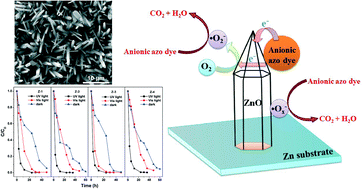Hydrothermal growth of ZnO nanorods on Zn substrates and their application in degradation of azo dyes under ambient conditions†
Abstract
A new type of catalytic material, large-scale ZnO nanorod arrays grown on self-source substrate, was directly synthesized by a facile hydrothermal approach. The catalytic activity of the ZnO nanocrystals with different exposed surfaces, including ZnO hexagonal nanorods with exposed reactive {0001} facets, hexagonal ZnO nanopyramids with nonpolar {01![[1 with combining macron]](https://www.rsc.org/images/entities/char_0031_0304.gif) 0} planes, and pencil-like morphology with exposed {10
0} planes, and pencil-like morphology with exposed {10![[1 with combining macron]](https://www.rsc.org/images/entities/char_0031_0304.gif) 1} polar planes, was tested towards the degradation of the azo dyes (Congo red (CR) and methyl orange (MO)). The aqueous azo dyes can be degraded efficiently under ambient conditions, requiring neither light illumination nor additional energy (agitation, ultrasonic, etc.). Systematic experiments suggested that the dye degradation proceeds through electron transfers from the anionic dye molecules to the catalyst and then to electron acceptors such as dissolved oxygen. It strongly depends on the exposed polar surfaces of the ZnO nanocrystals, giving rise to the relatively higher catalytic activity and stability of the ZnO hexagonal nanopencils. The present ZnO nanorod arrays grown on the Zn substrate require no additional reagents or external energy input, which thus provides a potentially low-cost alternative for the remediation of azo-dye effluents.
1} polar planes, was tested towards the degradation of the azo dyes (Congo red (CR) and methyl orange (MO)). The aqueous azo dyes can be degraded efficiently under ambient conditions, requiring neither light illumination nor additional energy (agitation, ultrasonic, etc.). Systematic experiments suggested that the dye degradation proceeds through electron transfers from the anionic dye molecules to the catalyst and then to electron acceptors such as dissolved oxygen. It strongly depends on the exposed polar surfaces of the ZnO nanocrystals, giving rise to the relatively higher catalytic activity and stability of the ZnO hexagonal nanopencils. The present ZnO nanorod arrays grown on the Zn substrate require no additional reagents or external energy input, which thus provides a potentially low-cost alternative for the remediation of azo-dye effluents.


 Please wait while we load your content...
Please wait while we load your content...